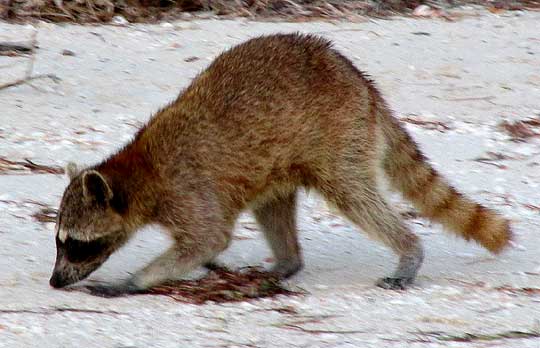Excerpts from Jim Conrad's
Naturalist Newsletter
from the May 31, 2015 Newsletter issued from Río Lagartos, on the Yucatan Peninsula's northern coast (~N21.60°, ~W88.16°), Yucatán state, MÉXICO
RACCONS WITH SLENDER TAILS
At dusk Wednesday night a pair of Raccoons wandered down a beach sniffing the white sand. We see lots of Raccoons at the mangrove's edge, so this was nothing special. Still, every time I see one I'm reminded of how small the ones here are, and how slender their tails, compared to those seen farther north. Below, you can see one of our slender-tailed ones:

Raccons are allowed to be variable, however, for they come in a variety of subspecies. The 2005 edition of Mammal Species of the World recognizes 22 subspecies of PROCYON LOTOR, which is the same Raccoon species found in Canada and the US, all the way south to Panama. Four of those subspecies occur only on small Central American and Caribbean islands, and one of those is thought to be extinct.
Subspecies, if given enough time, evolve into species, and one Raccoon form that most experts agree has graduated to being a full species lives a bit east of here. It's the Cozumel Raccoon, Procyon pygmaeus, also called the Pygmy Raccoon, regarded as critically endangered on Cozumel Island just off the Yucatan Peninsula's eastern coast.
from the March 3, 2007 Newsletter issued from Jalpan, Sierra Gorda Biosphere Reserve headquarters, Querétaro, MÉXICO
RACCOON/ MAPACHE
Last Saturday Roberto called across the parking lot: "We have a Raccoon over here." Of course he spoke in Spanish, and called the Raccoon a Mapache (ma-PACH- eh).
Mapache was in a cage and he had bright purple paws. With a stick Roberto was trying to pen the growling critter into a corner so that the veterinarian could inject rabies vaccine into his rear end. The purple was an antiseptic they'd been trying to spray onto a leg that jutted out the wrong way because it was broken, and cut badly. He'd been caught in a leg trap.
"A neighbor caught him and wanted to kill him, but his kids talked him out of it and then they brought him here. I'm about to drive him into the country to release him, so do you want to come along?"
On the way to drop off the veterinarian in town I asked the veterinarian about releasing a critter with a leg in such a bad shape.
"If he's kept in a cage he'll lose weight, get weak and die. But if he's in the wild he can walk on three legs, get the food he needs, keep up his strength, and eventually the wound will heal, though probably he'll always have a crooked paw."
Roberto and I took Mapache a good bit northwest of town, down the hot, dusty, oversized canyon of the Río Jalpan to a place well off the road, down some very rocky tracks, to a secluded spot called El Sabinal. It had permanent water with fish and frogs, and big trees with holes in them, so it looked like a perfect place for a raccoon. We let Mapache go there, and you can see him exiting the cage into the water below:

If you look at that picture and you know what a North American Raccoon is supposed to look like, see if you notice anything different about this one. He's the same species, PROCYON LOTOR, which is distributed from southern Canada to northern South America, so there shouldn't be major anatomical differences. However, about 35 subspecies are recognized, so there's room for noticeable regional differences.
What about Mapache's tail? Have you ever seen such a slender tail on a Raccoon? Roberto says that all Raccoons he's seen around here have slender tails, and he's sensitive to Raccoon tails because when he was a kid he wanted a Raccoon-tail cap like Davy Crockett's, but never got one.